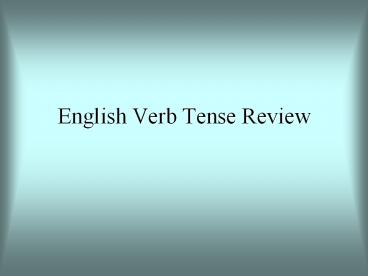English Verb Tense Review - PowerPoint PPT Presentation
Title:
English Verb Tense Review
Description:
English Verb Tense Review Simple Present Tense Otherwise known as the Timeless Present Simple Present Tense is used: When you are referring to habitual actions ... – PowerPoint PPT presentation
Number of Views:738
Avg rating:3.0/5.0
Title: English Verb Tense Review
1
English Verb Tense Review
2
Simple Present Tense
- Otherwise known as the
- Timeless Present
3
Simple Present Tense is used
- When you are referring to habitual
actions--actions that you always or never do - When you are referring to unchanging truths
- When you are making general statements of fact
4
Examples
- (habit) He always comes late to class.
- (unchanging truth) The sun rises in the east.
- (general statement of fact) They are friendly.
5
Indicators
6
Form
7
Diagram--time on a line
NOW
X X X X X X X X X X
Past
Future
8
Simple Past Tense
9
The Simple Past Tense is Used
- When an activity or situation began and ended at
a specified time in the past--in other words,
when an activity or situation is completed in the
past - To refer to past habits
10
Examples
- (Completed action in the past) He was late to
class yesterday. - (Completed action in the past) We arrived three
weeks ago. - (Past habit) She always wrote a letter to her
mother on Sunday night.
11
Indicators
12
Form
13
Diagram--time on a line
NOW
X
Future
Past
14
The Present Perfect
- A tense very commonly used in English to refer
to the past!
15
The Present Perfect is Used
- When an activity happened at an unspecified time
in the past (before the present) - When an activity has been repeated several times
before now - When an activity was very recently completed
before now - When an activity is not completed in the past
16
Examples
- (unspecified time before now) They have already
seen that movie. - (repeated activity before now) We have visited
New York City many times. - (an action has recently been completed before
now) I have just eaten. - (action not completed in the past) I have studied
Spanish for many years.
17
Indicators
18
Form 1have or has past participle
19
Form 2
20
Diagram 1--time on a line
NOW
X
?
Past
Future
21
Diagram 2--time on a line
NOW
X X X X X
Past
Future
22
The Present Progressive Tense
- Sometimes called the
- Present Continuous Tense
23
The Present Progressive Tense is Used
- When an activity is in progress now at the moment
of speaking - When an activity began before now and continues
into the future without stopping. - When an activity is temporary.
- When an activity is developing and changing.
24
Examples
- Im explaining something to the class right now.
- Hes taking 16 credits this semester.
- She is understanding English more and more
because she moved into the dorm.
25
Indicators
26
Form
27
Diagram--time on a line
NOW
Past
Future
28
Future Tense
29
The Future Tense is Used
- To indicate that an activity or event will take
place at a time in the future
30
Examples
- When Im retired, Im going to travel.
- Next week, we will work on punctuation.
- He is going to get his car fixed tomorrow.
- Our plane departs at noon next Friday.
31
Indicators
32
Form 1
33
Form 2
34
Form 3
35
Diagram--Time on a Line
NOW
X
Past
Future
36
Other English Verb Tenses
- These tenses are combinations of the tenses we
have just reviewed
37
Past Perfect
- This tense is not used a lot. It can often be
used interchangeably with the simple past because
these tenses do not differ much in meaning. The
past perfect tense refers to activities that
happened before a specific time in the past. - Example, He had visited her many times before she
died. - Form had past participle
38
Past Progressive
- This tense is used to refer to activities
continuously in progress around a time in the
past. - Example They were eating when the taxi arrived.
- Form was or were verbing
39
Past Perfect Progressive
- This tense is used when an activity was
continuously in progress before a specific time
in the past. - Example I had been thinking about her before she
called. - Form had been verbing
40
Present Perfect Progressive
- This tense is used to describe actions that have
been continuously in progress before now. These
actions are not completed. - Example I have been waiting here for the last
two hours. - Form have or has been verbing
41
Future Perfect
- The future perfect expresses the idea that an
activity will occur before some future time. - Example She will have finished dinner before the
game starts. - Form will have past participle
42
Future Progressive Tense
- This tense is used to refer to activities that
will be continuously in progress around some
future time. - Example We will be flying over New York at noon
tomorrow. - Form will be verbing
43
Future Perfect Progressive
- This tense is used to refer to activities that
will be continuously in progress before a future
time. - Example He will have been working for 3 hours
before you arrive. - Form will have been verbing
44
Overview of the English Verb Tense/Aspect System
Simple Perfect (HAVE verben) Progress-ive (BE verbing) Perfect Progress- ive (HAVE BEEN verbing)
Present
Past
Future
45
Acknowledgments
- The charts in this presentation were adapted from
the work of Betty Schrampfer Azar. She is the
author of Understanding and Using English Grammar
and many other useful ESL texts.
46
The End































